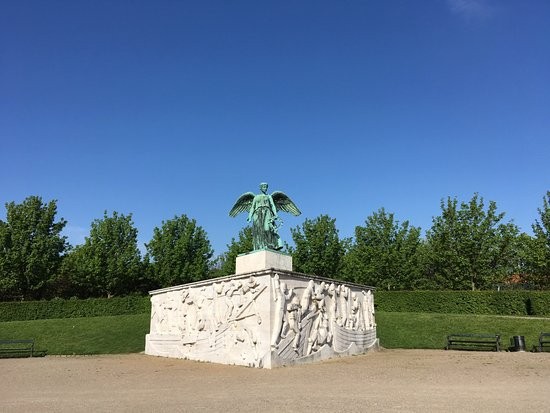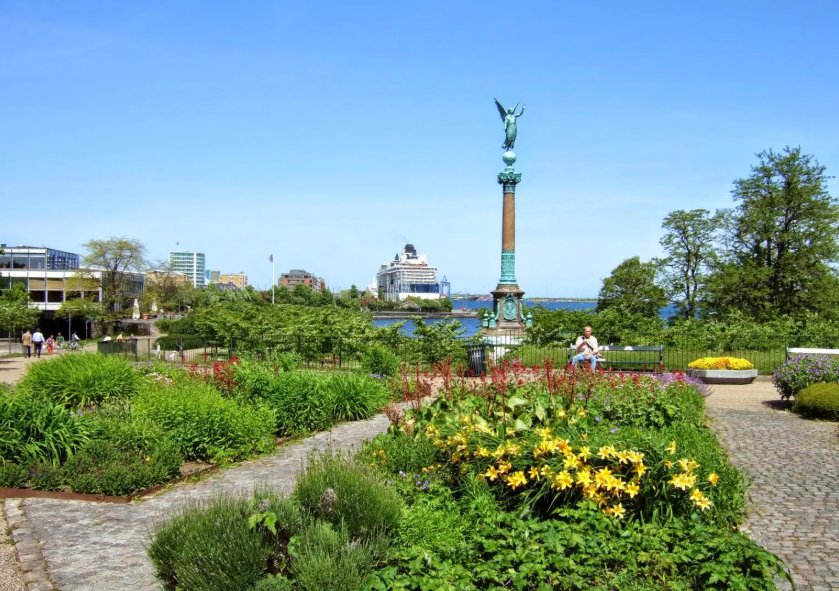Nestled along Copenhagen’s Langelinie promenade, close to the iconic Little Mermaid statue, stands a powerful and poignant tribute to the sacrifices made by Danish merchant sailors during World War I. The Statue of Peace, an enduring memorial, commemorates those who braved the seas and lost their lives in the Great War. This remarkable monument goes beyond national remembrance. It uniquely incorporates Italian marble into its base, symbolizing the historical and cultural bond between Denmark and Italy, while also promoting universal ideals of peace and sacrifice.
The Statue of Peace, unveiled in 1928, is not just a product of Danish artistic vision. It incorporates Italian artistry, making it a true blend of cultural heritage. The monument honors Denmark’s merchant sailors—648 in total—who were tragically killed at sea. The Italian marble base serves not only as an aesthetic choice but also as a profound statement about international cooperation and the timeless pursuit of peace. Its presence in Copenhagen is a reminder that the legacies of sacrifice and remembrance can transcend borders and unite nations.
Italian Marble: A Foundation of Timeless Tribute
The Italian marble that forms the base of the Statue of Peace is central to the monument’s narrative. This particular material was chosen not just for its aesthetic appeal but also for its enduring quality. Italian marble has been historically favored by sculptors for centuries, with its polished, elegant surface representing timeless beauty and strength. The decision to use this material is a symbolic gesture, linking Denmark’s tribute to the deep artistic and cultural traditions of Italy.

The beautiful statue of peace rests on an Italian marble base
The marble base of the statue is a canvas for intricate reliefs, beautifully carved representations of maritime life. It also bears the names of the 648 Danish sailors who lost their lives during World War I, immortalizing their memory. The use of Italian marble for such a deeply significant memorial elevates the monument, reminding visitors of the shared artistic and cultural heritage between Denmark and Italy. This cross-border connection adds another layer of meaning, where the reverence for the past is mirrored by the appreciation for artistic collaboration.
In addition to its visual appeal, the marble’s durability signifies the lasting nature of the memorial itself. While the historical sacrifices it commemorates are etched in stone, the monument’s ability to endure over time speaks to the resilience of peace efforts. As visitors look upon the statue, they can appreciate the importance of preserving the memory of those who gave their lives, while also recognizing that peace—much like the marble—is a foundation that must be carefully maintained.
Crafting Unity: How Denmark and Italy Collaborated on a Monument
The Statue of Peace was born out of a national competition aimed at honoring Denmark’s merchant sailors, who played an essential role in World War I. Sculptor Svend Rathsack and architect Ivar Bentsen were awarded the commission, and their combined vision led to the creation of this powerful tribute. The design of the statue incorporates Danish maritime elements, such as the figure of a sailor, while also drawing on broader European artistic traditions, particularly Italian sculpture.
The choice of Italian marble was not incidental. Italy, renowned for its high-quality marble, provided the perfect material for the base of the statue. This marble base becomes more than a decorative feature—it ties Denmark’s tribute to Italy’s centuries-old tradition of marble craftsmanship. The fusion of Danish history and Italian artistry reflects a broader cultural collaboration between the two nations, with the monument serving as a tangible symbol of international respect and unity.
In 1928, the unveiling of the monument was a momentous occasion for Denmark, as it solidified the country’s collective memory of the sacrifices made by its maritime workers. However, it was also a testament to the long-standing collaboration between Denmark and Italy in the fields of art and culture. The Statue of Peace thus becomes a celebration of the broader European commitment to peace, freedom, and remembrance, built on the foundational artistic excellence of Italy and the poignant maritime history of Denmark.
Artistry and Meaning: The Statue’s Symbolic Power
The Statue of Peace is much more than a monument commemorating Denmark’s World War I casualties—it’s a work of art that invites reflection on the larger themes of sacrifice, loss, and peace. The figure of the sailor, standing resolute against the sea, conveys the stoic nature of those who sailed in perilous conditions during wartime. The surrounding reliefs, etched into the Italian marble, portray the harsh realities of life at sea, highlighting the constant danger these sailors faced.
The monument’s location in Copenhagen, near the world-famous Little Mermaid statue, also enhances its symbolic value. Situated on the bustling Langelinie promenade, the statue draws countless visitors each year—locals and tourists alike—who stop to pay their respects or simply to admire its artistry. The juxtaposition of Danish history and Italian craftsmanship creates a multi-layered experience for those who interact with it.
One of the key elements of the statue is its ability to transcend its national origins. While it is a Danish memorial, its Italian base and its artistic features connect it to the larger European tradition of commemorating those lost in war. The monument becomes a universal symbol of human endurance, peace, and the hope that future generations will not forget the sacrifices of the past.
Italian Marble and Its Historic Legacy in Memorial Art
The use of Italian marble in the Statue of Peace is a deliberate nod to the long history of Italian influence on sculpture and memorial art. Italy has long been the center of marble sculpture, from the Renaissance masterpieces of Michelangelo to the contemporary memorials that continue to grace public spaces worldwide. By incorporating Italian marble into this Danish memorial, the statue connects Denmark to a broader European tradition that values artistry, craftsmanship, and solemn remembrance.
Marble is a material historically associated with beauty and dignity, and its use in memorials serves as a mark of reverence and respect. In the case of the Statue of Peace, the marble base elevates the memorial, transforming it into a timeless work of art. The marble’s enduring nature symbolizes the lasting memory of those who perished in war, while also representing the permanence of peace as a goal that should never be forgotten.
The monument also reinforces the strong cultural bond between Denmark and Italy. Italy, with its wealth of artistic history, brings a rich heritage of sculptural excellence to this Danish tribute. By choosing Italian marble, Denmark acknowledges the role that international cooperation plays in shaping powerful monuments that honor shared values and ideals.
A Cross-Cultural Experience: Reflecting on History and Peace
For visitors to Copenhagen, the Statue of Peace provides a unique opportunity to reflect on the cost of war and the value of peace. It is more than just a local memorial; it is a cross-cultural space that invites people from around the world to engage with its message. The Italian marble base, with its detailed reliefs and inscriptions, becomes a point of connection between Denmark’s maritime history and Italy’s sculptural traditions.
The serene expression of the statue and the polished Italian marble offer a moment of quiet reflection. For many, it is a space to connect with the past, consider the ongoing struggle for peace, and recognize the importance of international unity. The statue serves as both a tribute to the past and a hopeful vision for the future, where the pursuit of peace transcends borders and cultures.
Connecting Two Nations: Italy and Denmark’s Shared Legacy of Peace
Ultimately, the Statue of Peace is more than a memorial to Danish merchant sailors—it is a representation of the lasting bond between Denmark and Italy. The marble base symbolizes this connection, serving as a reminder that international cooperation and shared values can create powerful works of art that speak to the entire world.
The Statue of Peace stands resolutely along Copenhagen’s waterfront, a symbol of peace, sacrifice, and international unity. It reminds all who encounter it that the pursuit of peace is a collective effort that requires collaboration across borders and cultures. This enduring monument, crafted from Italian marble, serves as a timeless reminder of the price of war and the enduring importance of peace.
 Heart
Heart Haha
Haha Love
Love Wow
Wow Yay
Yay Sad
Sad Poop
Poop Angry
Angry

